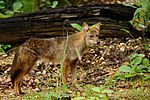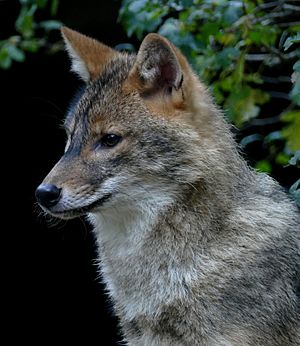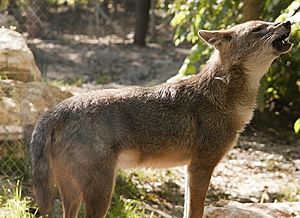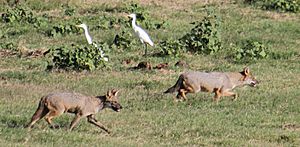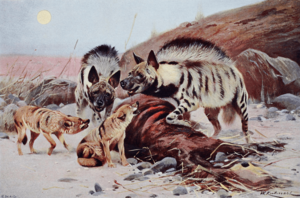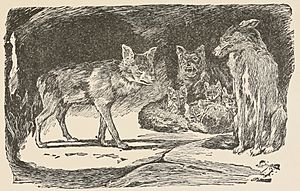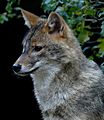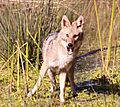Golden jackal facts for kids
Quick facts for kids Golden jackal |
|
|---|---|
 |
|
| Golden jackal in Tel Aviv | |
| Conservation status | |
| Scientific classification | |
| Subspecies | |
|
|
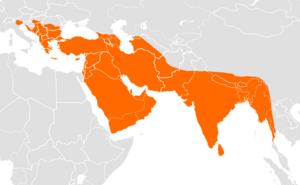 |
|
| Range of the golden jackal (note: distribution north of the Black Sea not mapped) |
The golden jackal (Canis aureus), also known as the common jackal, is a wild dog that looks a bit like a wolf. It lives in many parts of the world, including Southeast Europe, Central Asia, Western Asia, South Asia, and some areas of Southeast Asia.
Golden jackals have fur that changes color. In summer, it can be a pale creamy yellow. In winter, it turns a darker brownish-yellow. They are smaller than most wolves. They have shorter legs and tails, a longer body, and a narrower snout.
Even though they are called "jackals," golden jackals are not closely related to the African black-backed or side-striped jackals. Instead, they are more like wolves and coyotes. Scientists believe their ancestor was an extinct dog called the Arno river dog. This animal lived in southern Europe about 1.9 million years ago.
Golden jackals are very common. They are found in many places and there are lots of them. This is why they are listed as "Least Concern" by the IUCN Red List. This means they are not currently in danger of disappearing.
These animals are very good at adapting to different places. They can eat many kinds of food, from fruits and insects to small animals. They are social animals, often living in pairs with their young. Golden jackals are now spreading from Southeast Europe into Central and Northeast Europe. They often move into areas where there are not many wolves.
Contents
What's in a Name?
The word 'jackal' first came into the English language around the year 1600. It comes from the Turkish word çakal. This word originally came from the Persian word šagāl. The golden jackal is also known as the common jackal.
Jackal Family Tree
The dog family, called Canidae, includes many animals. These are South American canids, fox-like canids, and wolf-like canids. Golden jackals belong to the wolf-like canids. All animals in this group have 78 chromosomes. This means they can sometimes have babies together.
The jackal group includes the black-backed jackal, the side-striped jackal, and the golden jackal. These three animals are similar in size and body shape. They are mainly told apart by their fur color. For a long time, people thought all jackals were very closely related. However, genetic studies show that they are not. The golden jackal is actually more closely related to wolves and coyotes than to the other two jackal species.
Scientists study Mitochondrial DNA (mDNA) to learn about animal family histories. A study in 2005 showed that the gray wolf and dog are most closely related. After them come the coyote, golden jackal, and Ethiopian wolf. These animals can even have hybrid babies with dogs in the wild.
In 2015, a big DNA study looked at golden jackals. It found that the golden jackals in Africa were actually a different species. They are now called the African wolf. This means there are fewer subspecies of the golden jackal than once thought. The study showed that golden jackals and African wolves look very similar. This is why scientists used to think they were the same.
How Jackals Evolved
{{Cladogram|align=right|title=Phylogenetic tree of the wolf-like canids with timing in millions of years |cladogram=
| Caninae 3.5 Ma |
|
||||||||||||||||||||||||||||||||||||||||||||||||||||||||||||
The Arno river dog was an extinct type of canine. It lived in southern Europe about 1.9 million years ago. This small, jackal-like dog is likely the ancestor of today's golden jackals. Its body structure is more like the golden jackal than the African jackal species.
The oldest golden jackal fossil found is a tooth fragment. It was discovered in Lebanon and is about 7,600 years old. In Europe, the oldest fossils are from Greece, dating back 7,000–6,500 years.
Genetic studies show that golden jackals first spread from India. This happened about 20,000 years ago, after the last Ice Age. India had warmer areas that helped them survive the cold. As the world warmed, they moved out of India into the Middle East and Europe.
Today, golden jackals in India have the most genetic variety. This supports the idea that they originated there. Jackals in Europe have less genetic variety, meaning they arrived there more recently.
Jackal Subspecies
The golden jackal was first named by Carl Linnaeus in 1758. Since then, 13 subspecies have been described. After the African wolf was identified as a separate species, the number of golden jackal subspecies was reduced to seven.
| Subspecies | Trinomial authority | Description | Distribution | Synonyms |
|---|---|---|---|---|
| Persian jackal
C. a. aureus |
Linnaeus, 1758 | This jackal is large with soft, pale fur. Its fur is mostly sandy colored with black and white hairs. It weighs about 8–10 kg (18–22 lb). | Middle East, Iran, Turkmenistan, Afghanistan, Pakistan and Western India. |
hadramauticus (Noack, 1896) |
| Indochinese jackal | Matschie, 1900 | This jackal is smaller than the Indian jackal, weighing up to 8 kg (18 lb). Its fur looks much like a dog's. It lives in mountains near farms or forests. It eats small animals like birds, reptiles, and frogs, and sometimes fruits. It can be active day or night. | Thailand | |
| Indian jackal | Hodgson, 1833 | Its fur is a mix of black and white, with buff colors on its shoulders, ears, and legs. It can grow up to 100 cm (39 in) long and weigh 8–11 kg (18–24 lb). | India, Nepal, Bangladesh, Bhutan | |
| European jackal | I. Geoffroy Saint-Hilaire, 1835 | This is the largest golden jackal subspecies. Males and females average 120–125 cm (47–49 in) long. They weigh 10–15 kg (22–33 lb). Their fur is coarse and often has blackish tones on the back. | Southeastern Europe, Moldova, Asia Minor and the Caucasus |
graecus (Wagner, 1841) balcanicus (Brusina, 1892) |
| Sri Lankan jackal | Wroughton, 1916 | It measures 67–74 cm (26–29 in) long and weighs 5–8.6 kg (11–19 lb). Its winter coat is shorter and darker on the back. | Coastal South West India, Sri Lanka | lanka (Wroughton, 1838) |
| Syrian jackal | Hemprich and Ehrenberg, 1833 | This jackal has brown ears. Its body fur is yellow on the back, lighter on the sides, and whitish-yellow underneath. It measures 60–90 cm (24–35 in) long and weighs 5–12 kg (11–26 lb). | Israel, Syria, Lebanon, and Jordan |
What Golden Jackals Look Like
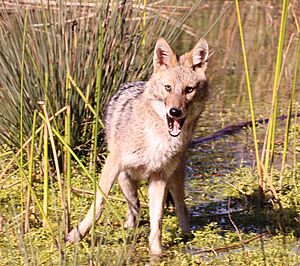
The golden jackal looks like a smaller version of a gray wolf. It has a longer body, a less noticeable forehead, and a narrower, more pointed snout. Its legs are long and slender. Males are usually 71–85 cm (28–33 in) long, and females are 69–73 cm (27–29 in) long. Males weigh 6–14 kg (13–31 lb), and females weigh 7–11 kg (15–24 lb). They stand about 45–50 cm (18–20 in) tall at the shoulder.
The golden jackal's skull is most similar to that of a dingo. It is smaller and less heavy than a wolf's skull. Its teeth are strong but thinner than a wolf's. These skull features show that the jackal eats smaller prey. This includes small birds, rodents, insects, dead animals, fruits, and some plants.
Sometimes, a golden jackal can grow a small, bony bump on its skull. It's called a "jackal's horn" and is usually about 1.3 cm (0.5 in) long. It's hidden by fur. In the past, people in Sri Lanka thought this horn had magical powers.
The jackal's fur is rough and short. Its main color is golden. This color changes with the seasons, from a pale creamy yellow to a dark brownish-yellow. The fur on its back is a mix of black, brown, and white hairs. This can sometimes make it look like it has a dark "saddle" on its back. The fur on its belly is light, from pale ginger to cream. Each jackal has unique light markings on its throat and chest.
Jackals living in high places often have more buff-colored fur. Those in rocky, mountainous areas might have grayer fur. Their bushy tail has a tan to black tip. Some golden jackals can have very dark fur, which is called melanism. This dark color might help them adapt to their environment.
Golden jackals shed their fur twice a year, in spring and autumn. The spring shedding starts in late winter and lasts about 60–65 days. The autumn shedding happens from mid-September. New winter fur grows in, and the summer fur falls out at the same time. By the end of November, they have their full winter coat.
Where Golden Jackals Live
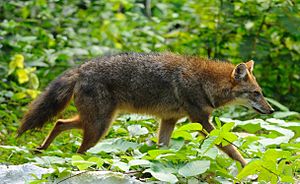
Golden jackals are found in many countries across Asia and Europe.
In South Asia, they live in:
- Afghanistan
- Pakistan
- Sri Lanka
- Bangladesh
- Myanmar
- Thailand
- India
- Nepal
- Bhutan
In Central Asia, they live in:
- Tajikistan
- Turkmenistan
- Uzbekistan
In Southwestern Asia, they live in:
- Iran
- Iraq
- Israel
- Jordan
- Kuwait
- Lebanon
- Oman
- Saudi Arabia
- Qatar
- Syria
- Turkey
- United Arab Emirates
- Yemen
In Europe, they live in:
- Albania
- Armenia
- Austria
- Azerbaijan
- Bosnia and Herzegovina
- Bulgaria
- Croatia
- Estonia
- Georgia
- Greece
- Hungary
- Italy
- Kosovo
- Latvia
- Lithuania
- Macedonia
- Moldova
- Montenegro
- Poland
- Romania
- Russia
- Serbia
- Slovakia
- Slovenia
- Switzerland
- Turkey
- Ukraine
They have also been seen in Belarus, the Czech Republic, Germany, Denmark, the Netherlands, Finland, and Norway. In Estonia, a group of golden jackals has adapted to the colder northern climate.
Golden jackals can eat many different foods. This helps them live in various places. They can also go without water for a long time. They are common in valleys, near rivers, lakes, and seashores. They are less common in mountains.
In Central Asia, they avoid very dry deserts. But in India, they can live in the Thar Desert. They like to live in thick bushes, reed beds, and forests. They can climb up to 1,000 meters (3,300 ft) in the Himalayas. They can handle very cold temperatures, sometimes as low as -35°C (-31°F). However, they don't like deep snow. In snowy areas, they often use paths made by larger animals or humans.
What Golden Jackals Eat
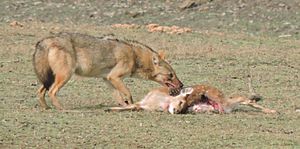
Golden jackals are like the coyote in North America. They are both predators and scavengers. This means they hunt animals and also eat dead animals. They eat many different things depending on where they live and the time of year.
In India, more than 60% of their diet is rodents, birds, and fruit. In other parts of India, 80% of their diet is rodents, reptiles, and fruit. They also eat plants like berries and pods from trees. Jackals will also eat leftovers from kills made by bigger animals like lions, tigers, and wolves. In some areas, they survive by eating dead animals and garbage. They often bury extra food to save it for later.
In the Caucasus region, golden jackals mainly hunt hares and small rodents. They also eat birds like pheasants and ducks. They enjoy fruits like pears and hawthorn berries. Sometimes, they damage crops like grapes, watermelons, and nuts.
In Serbia, they often eat dead farm animals. This might be helping their population grow. In Hungary, they mostly eat voles (small rodents) and wild boar carcasses. In Israel, golden jackals are important predators of snakes. When there were fewer jackals, more people reported snakebites.
Jackal Behavior
Social Life
Golden jackals change how they live together based on how much food is available. The main group is usually a breeding pair and their young. In India, you might see single jackals, pairs, or small family groups of up to 4–5 animals.
They use scent to mark their territory, especially around their dens and on common paths. This helps them protect their home. The hunting areas of different jackals can sometimes overlap. Jackals can travel 12–15 km (7–9 mi) in one night looking for food or a better place to live.
Jackals often greet each other, groom each other, and howl together. Howling is more common from December to April when they are finding partners and breeding. This suggests howling helps them mark their territory and defend it. Adult jackals howl standing up, while young or less dominant ones howl sitting.
Jackals are easy to make howl. One jackal's howl can make others nearby howl back. Their howl starts with low sounds and gets higher. It's like a wail repeated 3–4 times, followed by three short yelps. They usually howl at dawn and in the evening, and sometimes at midday. They might even howl when they hear church bells or sirens. When the weather changes, they often howl for a long time. Jackals, wolves, and coyotes will all go towards the sound of howling. Golden jackals make a special warning call when they see big predators like wolves or tigers.
Reproduction and Life Cycle
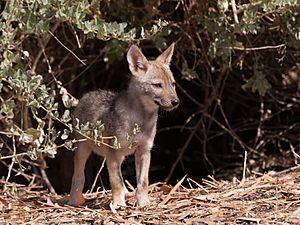
Golden jackals usually stay with one partner for their whole lives. Female jackals have babies once a year. They breed from October to March in Israel, and from February to March in other places like India. The mating period lasts about 26–28 days.
In India, golden jackals often use dens that other animals like foxes or porcupines have left behind. They might also use old wolf dens. Most jackal pairs keep their dens far apart from other pairs. They dig their dens from late April to May. Dens are often found in bushy areas, gullies, or along riverbanks. They can be 2–3 meters (7–10 ft) long and 0.5–1 meter (1.6–3.3 ft) deep, with 1–3 openings. The male jackal helps dig the den and raise the pups.
Golden jackal pups are born with their eyes closed. Their eyes open after 8–11 days, and their ears stand up after 10–13 days. Their first teeth appear at 11 days old. Pups are born with soft fur that is light gray to dark brown. At one month old, they shed this fur and grow new reddish fur with black spots.
Pups grow quickly. They weigh about 0.2 kg (0.4 lb) at two days old. At one month, they weigh 0.5–0.7 kg (1.1–1.6 lb). By four months, they are 2.7–3.2 kg (6–7 lb). Mother jackals feed their pups milk for 8–10 weeks. Pups start eating meat when they are 15–20 days old.
Unlike dog pups, golden jackal pups can be quite aggressive with their siblings when they are 4–6 weeks old. This fighting stops by 10–12 weeks when they form a social order. Once they stop drinking milk, the mother drives the pups away. Young jackals leave their mother in early autumn, either alone or in small groups. Females can have their own babies at 10–11 months old, and males at 21–22 months.
Hunting for Food
Golden jackals often hunt alone or in pairs. They rarely hunt in large packs. When hunting alone, they trot around, stopping to sniff and listen. Once they find prey, they hide, quickly get close, and then pounce. Single jackals hunt rodents, hares, and birds. They can find rodents in grass by listening carefully, then jumping high and pouncing on them. In India, they can dig out small rodents from their burrows. They can also hunt young, old, or sick hoofed animals that are 4–5 times their own weight.
When hunting in pairs or small groups, jackals run next to their prey and catch it together. If they are hunting water animals or birds, they might run along both sides of a narrow river. This helps them drive the prey towards each other.
Sometimes, golden jackals hunt monkeys called langurs in India. Packs of 5 to 18 jackals have been seen eating large dead animals in India and Israel. In some areas, groups of 8–12 jackals have been seen together in summer.
Working Together
In Southeast Asia, golden jackals have been known to hunt alongside packs of dholes (another type of wild dog). In India, they have been seen following Indian wolves to eat leftovers from their kills. The wolves don't seem to mind.
Sometimes, a lone jackal that has been kicked out of its own pack will follow a tiger. These jackals, called kol-bahl, stay a safe distance from the tiger and eat what the tiger leaves behind. A kol-bahl might even bark loudly to warn a tiger about prey. Tigers have been known to tolerate these jackals.
Jackal Rivals
Golden jackals compete for food and territory with animals like the red fox, wolf, and wildcat. Wolves are stronger than jackals, and jackals are stronger than foxes. If a wolf pack moves into an area, jackals will usually leave. Scientists have played recordings of jackal calls, and wolves came to chase away the perceived rivals. Dogs also reacted aggressively to these calls.
The golden jackal has been spreading across Europe. This is partly because wolf populations in many areas were wiped out. Where wolves are rare, jackals can move in more easily.
Red foxes and golden jackals eat similar foods. However, red foxes are afraid of jackals because jackals are three times bigger. Fox populations usually go down where jackals are common. Foxes can only be found at the edges of jackal territory. Striped hyenas also hunt golden jackals.
A study in 2022 found that golden jackals in Eastern Europe help reduce the number of invasive raccoon dogs. This is a good thing for the local environment.
Jackals and Health
Golden jackals can carry diseases and parasites that might harm humans or other animals. These include rabies and a parasite that can cause a disease called leishmaniasis in people. Jackals can also spread diseases like canine distemper to dogs.
They can carry many types of worms, ticks, and fleas. For example, in Tajikistan, jackals can carry up to 16 types of worms. Some of these worms can infect water. If people drink this infected water, they can get sick.
In Europe, as jackals spread, they can bring these parasites to new areas where they didn't exist before.
Protecting Golden Jackals
The golden jackal is listed as "Least Concern" by the IUCN Red List. This means it is not in danger of becoming extinct. They are common in many places and have lots of food and shelter.
In Europe, golden jackals are protected by several international agreements. These agreements aim to help protect native wildlife. However, some governments argue that the golden jackal is not native to all parts of Europe.
There are an estimated 70,000 golden jackals in Europe. They are fully protected in countries like Albania, Germany, Italy, Poland, and Switzerland. In other countries like Bulgaria and Croatia, they can be hunted.
In India, the golden jackal is found in almost all protected areas. It is listed under the Wildlife Protection Act, 1972. This gives it some legal protection to help control the trade of their fur and tails.
Jackals and People
In Stories and Myths
Golden jackals appear in many Indian stories and ancient texts. They are often shown as smart and clever animals. For example, in the Mahabharata, a jackal tricks a tiger, wolf, mongoose, and mouse so he can eat a gazelle by himself. In Buddhist tales, the jackal is seen as cunning, much like the fox in European stories.
In Hinduism, the jackal is sometimes linked to certain gods. For example, the goddess Kali is said to live in cremation grounds and be surrounded by millions of jackals. The goddess Durga was also often connected to the jackal. Jackals are sometimes seen as the "vehicles" (or mounts) of protective gods in Tibet.
In Rudyard Kipling's The Jungle Book, the character Tabaqui is a jackal. The wolf pack dislikes him because he is sneaky, eats scraps, and serves the tiger, Shere Khan.
Attacks on Humans
In a forest area in eastern India, there were no reports of jackal attacks on humans before 1997. However, between 1998 and 2005, there were 220 reported attacks. None of these attacks were deadly. Most happened in villages, forests, and farm fields.
Jackals build their dens in rocky hills. But human farms and homes have moved into these areas. This means jackals have to go into villages to find food, which leads to conflicts with people. People in this area often chase jackals away, which can make the jackals aggressive. Female jackals with pups are more likely to attack than lone males. There are no known attacks on humans by golden jackals in Europe.
Impact on Farms and Animals
Golden jackals can be a problem for farmers. They attack farm animals like turkeys, lambs, sheep, goats, and even young water buffalo. They also hunt valuable game animals like newborn deer, hares, and pheasants. They can damage crops like grapes, corn, and sugarcane. They also eat watermelons, muskmelons, and nuts.
In Greece, jackals cause less damage to farm animals than wolves or red foxes. But if there are many jackals, they can become a serious problem for small farm animals. In Bulgaria, over 1,000 attacks on sheep and lambs were reported between 1982 and 1987. The high number of attacks in Bulgaria and Israel is partly because there are not enough ways to prevent them. Also, lots of food in illegal garbage dumps can cause jackal populations to grow very quickly.
Jackals are also very harmful to animals raised for fur, like coypu and muskrats. They can completely wipe out coypu in shallow waters. Jackals also harm the fur industry by eating muskrats caught in traps or taking skins left out to dry.
Jackal Hunting

During British rule in India, people used to hunt golden jackals on horseback with hounds. This was like fox hunting in England. Jackals were not seen as beautiful as foxes, but they were known for their strength and how long they could run during a chase. One chase lasted 3.5 hours!
Jackals were hunted in three ways: with fast greyhounds, with foxhounds, or with mixed groups of dogs. Hunting with greyhounds was not considered good sport because greyhounds were too fast. Mixed groups were hard to control.
Some local people in India, like the Kolis and Vaghirs, hunt and eat golden jackals. However, most South Asian cultures consider the animal unclean. In the former Soviet Union, jackals are not actively hunted. They are usually caught by accident in traps or during hunts for other animals.
Using Jackal Fur
In Russia and other former Soviet Union countries, golden jackals are not considered to have high-quality fur. Their fur is thin, rough, and not very colorful. Jackal skins are used to make collars, women's coats, and fur coats. In the 1880s, thousands of jackal furs were collected in Russia and sent to fairs. By the 1930s, 20,000–25,000 jackal skins were processed each year in the Soviet Union. Most of these were sent to the United States.
Sulimov Dogs

There is a sculpture from ancient Turkey, 11,000 years ago, that shows a man holding a jackal. This suggests that golden jackals might have been tamed back then. In the 19th century, explorers noted that people in the Middle East kept golden jackals in their homes. Some people even bred their dogs with jackals.
In Russia, a scientist named Klim Sulimov started breeding dogs with their wild relatives. He wanted to improve their ability to detect scents. He believed that dogs had lost some of their scent-detecting skills during domestication. Sulimov crossed European jackals with a type of Russian dog called Laikas, and also with fox terriers. He used jackals because he thought they were the wild ancestors of dogs and had better scent skills. He also liked that they were smaller and tougher than dogs, so they could live outside in the Russian climate.
Sulimov's program continues today. Hybrid dogs, called Sulimov dogs, are used at Sheremetyevo Airport near Moscow. They are used by the airline Aeroflot to detect scents.
Some people have criticized this program. They say that other dog breeds, like the Laika, perform just as well as the jackal hybrids. More research is needed to fully understand the benefits of these hybrid dogs.
Images for kids
See also
 In Spanish: Chacal común para niños
In Spanish: Chacal común para niños




